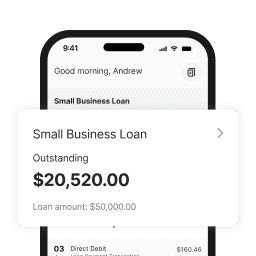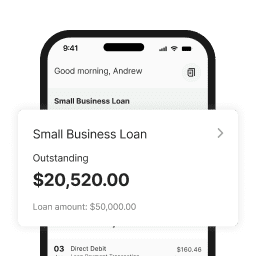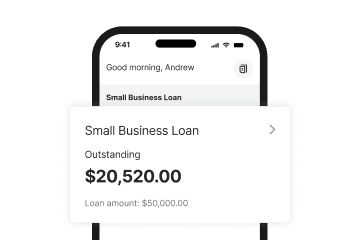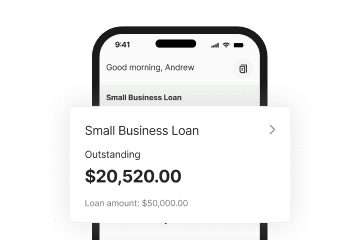Deciding between a business loan and a business line of credit? Learn whether a lump-sum loan for planned growth or a flexible line of credit for cash flow is the right choice for your goals.
At a glance
- Choosing the right funding starts with diagnosing your business need first: are you funding a single, large investment or managing ongoing, unpredictable cash flow?
- A business loan provides budget certainty with predictable repayments on the full amount, while a business line of credit allows you to control costs by only paying interest on the funds you actually use.
- With unsecured funding, you can access capital based on your business's health, allowing you to move faster without needing to risk personal assets.
When you’re looking for funding, it’s easy to get lost comparing interest rates, terms and product features. But this can be misleading. The most important factor is what your business needs. Is your goal to fund a single, major investment, or to manage the day-to-day rhythm of your cash flow? This guide will help you choose the most suitable solution to solve your specific need.
What is a business loan and a business line of credit?
While both provide access to capital, they are designed for two distinct business purposes: one is for funding strategic growth, while the other is for managing fluctuating cash flow.
Business loan
When you have a specific growth project in mind, a small business loan provides the capital and certainty to make it happen. It’s set up as a one-time lump sum that you repay over a set term, which is ideal for a significant, planned investment where you know the total cost upfront.
Let’s imagine you run a growing online retail store and you’re ready to expand by leasing your first warehouse. A loan provides the exact funds needed for the bond, rent, and fit-out costs in a single payment, giving you the capital to confidently execute your growth plan.
This is a common strategy for growth, as Craig Taplin, owner of footwear brand Aussie Soles, found when scaling his inventory to meet demand.

“Prospa Business Loans have given me the ability to expand the range, as I’ve wanted to add in new products, and it’s given me the ability to order larger quantities, through my pre-season orders.”
— Craig Taplin, Aussie Soles CEO and Founder
Business line of credit
A business line of credit is intended to help you handle unforeseen challenges without disrupting your operations. It offers a flexible funding facility up to an approved limit, where you can draw funds as needed and repay as you go, ensuring it is ready for the next time a need arises.
Using our online retail store example, imagine a large shipment of your key product arrives from overseas but is held at customs with an unexpected import tax bill that must be paid before the goods can be released. A line of credit allows you to draw the exact amount needed to clear the shipment immediately, preventing stock shortages and lost sales.
This is exactly the kind of confidence that Lily Kahramanian of Workdog Creative describes. For her, having a flexible funding option was essential while navigating a period of change.

“A Prospa Business Line of Credit was like a security blanket while we trialed and tested our new business model. We only pay interest on what we’re using and often we’ll pay it all out at the end of the month with the full funds available again, which works a treat.”
— Lily Kahramanian, Workdog Creative Owner
| Feature | Business loan | Business line of credit |
|---|---|---|
| Best for | Large, planned, one-off purchases and strategic investments. | Managing ongoing, day-to-day cash flow needs. |
| Funding structure | A one-time lump sum paid into your account upfront. | Access to a pool of funds you can draw from as needed. |
| Repayments | A predictable schedule of fixed repayments over a set term. | Flexible repayments; you can pay down and redraw funds. |
| Cost model | You pay interest on the total loan amount from the start. | You only pay interest on what you use. |
The key difference between a business loan and a line of credit
Each product is built for a specific purpose which dictates their structure and, ultimately, how the funds are delivered to your business.
Let’s return to our example of securing a warehouse. Imagine you’ve calculated the total upfront costs and you need $20,000 to move forward. A small business loan solves exactly this kind of challenge. The full $20,000 would be delivered to your account in a single transfer, giving you the exact capital required for the bond, rent, and fit-out. It’s funding for a specific, defined purpose.
Now, consider the unpredictable nature of running your online store. One week, a major corporate client pays their invoice late, leaving you short for payroll. The next, a shipment of your best product is held at customs with an unexpected tax bill. Then, you get a last-minute invitation to a high-profile trade show that requires an immediate fee to secure your spot.
This is where a business line of credit comes into play. With an approved facility, say, $20,000, acting as a safety net, you don’t receive the money upfront. Instead, when needed, you draw $8,000 to cover payroll, then another $3,500 to clear your goods from customs, and finally $2,000 to secure the trade show spot, all from the same facility. It provides a buffer to manage the natural peaks and troughs of your cash flow.
Understanding costs and repayments
Beyond how you access the funds, the way you repay them and how costs are calculated are also important factors.
With a business loan, there are no surprises when it comes to repayments. If you secure the $20,000 for the warehouse expansion, the repayment schedule is locked in from the beginning. You’ll have a clear plan of daily or weekly repayments, and you’ll know the exact amount of each one for the entire term, which makes cash flow forecasting simple. Because you receive the funds as a single lump sum, interest is calculated on the total $20,000 from the outset, and each repayment includes a portion of both the principal and the interest.
A business line of credit operates on a pay-for-what-you-use basis, giving you control over your costs. Let’s return to our shipment being held at customs with an unexpected tax bill of $3,500 that must be paid to release the goods.
With a $20,000 facility, you would draw only the $3,500 needed to solve that specific problem. You only accrue interest on that outstanding $3,500, not the entire facility. Once you sell the cleared stock and repay the funds, the interest charges stop, and your full $20,000 facility is available again for the next time an opportunity or need arises.
Comparison: Accessing $20,000 with a business loan or line of credit
To make this clearer, here is a simple side-by-side comparison using our online retail store example:
| Business loan | Business line of credit | |
|---|---|---|
| The scenario | Your online store takes a $20,000 loan to fund its new warehouse fit-out | Your online store has a $20,000 facility to manage unforeseen expenses |
| Access to funding | The full $20,000 is delivered to your account upfront | You draw only the $3,500 needed to pay an unexpected customs bill |
| Repayment structure | Predictable, scheduled repayments (e.g., daily or weekly) over a set term | You can repay the $3,500 as you see fit, for example, over the next three months |
| Cost model | Interest is calculated on the total $20,000 loan amount from the start | Interest is only calculated on the outstanding $3,500 you have drawn |
| One-off vs ongoing | Once the final repayment is made, the loan is complete and the facility is closed | Once repaid, the full $20,000 facility is available again for future use, with no further costs |
How unsecured funding helps you move fast without collateral
For many business owners, a major hesitation around funding is the traditional requirement to secure a loan against a personal asset, in most cases the family home. This process can be slow, complex, and adds a significant layer of personal risk to a business decision.
This is precisely why both the Prospa Business Loan and Line of Credit do not require upfront security up to $150K. Instead of focusing on the value of your assets, the application focuses on the health of your business and its cash flow.
These are some of the benefits for you as the owner:
- It’s faster. With no need for lengthy property valuations, the application and approval process is quicker. In many cases, a decision can be made and funds can be in your account in under 24 hours.
- It’s simpler. The process involves less paperwork. For many applications, all that’s required are some basic business details, your ABN, and access to your business bank account information.
- It brings peace of mind. It separates your business finances from your personal assets, allowing you to pursue growth opportunities with confidence, knowing your home isn’t on the line.
Unsecured funding means your application is assessed based on its performance and potential. This focus on your business itself is what makes securing capital faster and more straightforward, removing the hurdles many Australian businesses encounter with traditional lenders.
By now, you should have a clearer picture of which funding option best aligns with your goals. With the Prospa calculator, you can have a real-time projection of your weekly repayments and fees for both options.
Ready to see your numbers? See how much your business could borrow in just two minutes.








